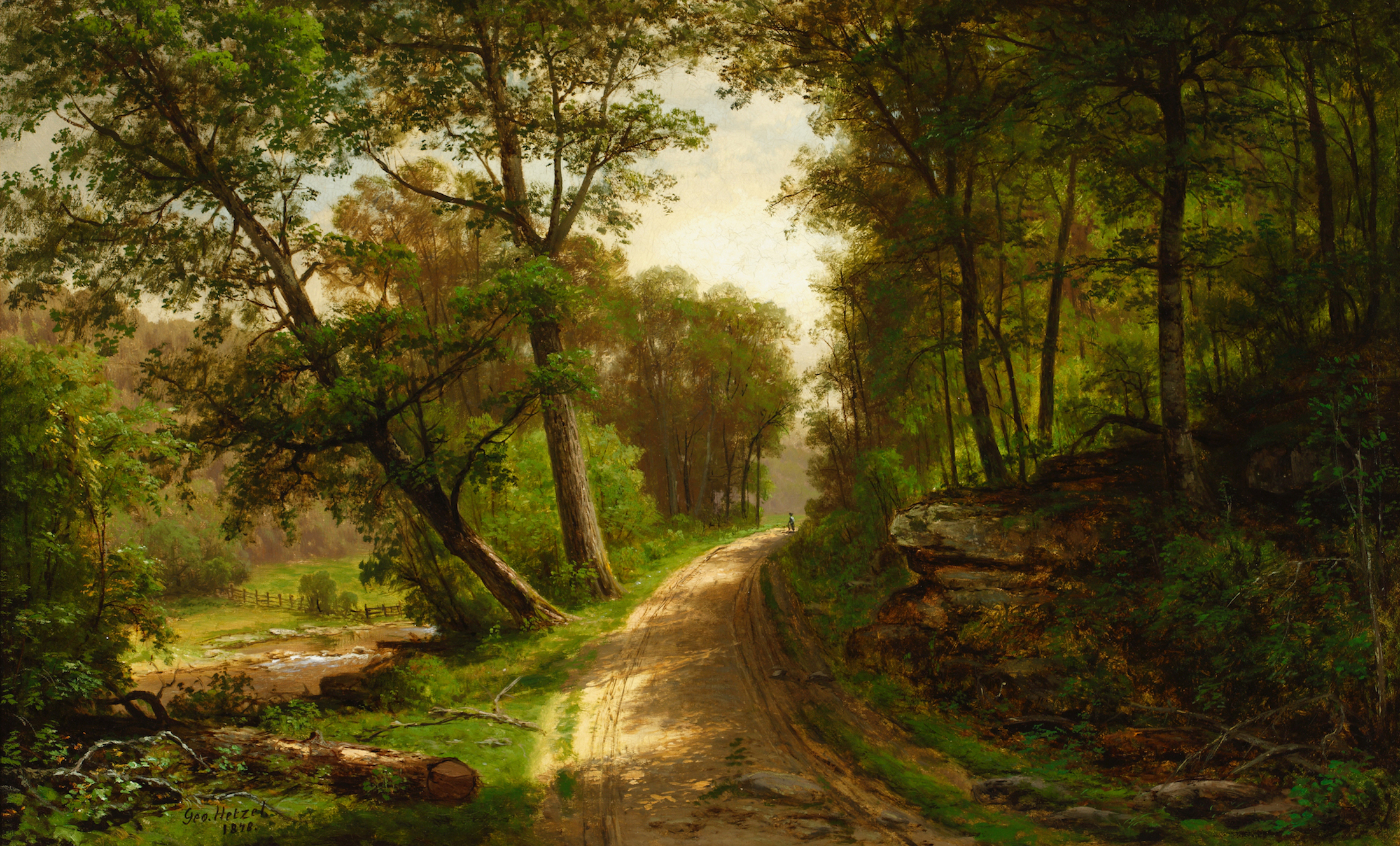Take a Walk Down a Country Road
Even though Westmoreland County has moved into the Green Phase of the Plan to Reopen Pennsylvania, many of us are still practicing social distancing and still experiencing a bit of cabin fever.
Some good ways to help cope with cabin fever are establishing a routine, transporting yourself to someplace else, and connecting with nature. Today, we invite you to transport yourself to George Hetzel’s Country Road.
Country Road is a prime example of artist George Hetzel’s landscape paintings. The location could be any one of Hetzel’s favorite countryside locales in Southwestern Pennsylvania; it shows a dirt road, deeply rutted by wagon wheels, winding its way into the interior of a forest. In the far distance, a man can be seen walking the length of the road. Dense trees and foliage to the right and left allow only a small area of blue sky to be seen, a convention found in many of Hetzel’s landscape views. To the left, a stream replete with tiny rapids meanders through a secluded meadow. The attention to detail, dark palette, and filtered light are all characteristics of Hetzel’s mature style.
Hetzel’s family had immigrated to America and settled in Allegheny City, now part of Pittsburgh’s North Side, in 1828, two years after he was born. After a four-year apprenticeship to a house and sign painter, Hetzel enrolled in the Dussseldorf Academy in 1847, one of the foremost art schools in Europe at that time, where he was trained to observe naturalistic detail, render them in a precise manner, and utilize the technique of chiaroscuro, which uses light and dark to achieve mass and dramatic three-dimensional effects. He studied for two years until 1849 when Germany’s growing political unrest forced his return to Pittsburgh.
Once home, Hetzel painted highly detailed portraits and still life paintings in the precise style he acquired in Germany. In 1855, he exhibited for the first time in Philadelphia at the Pennsylvania Academy of the Fine Arts, submitting three still lifes. Two years later, his first submissions to the annual exhibition at the National Academy of Design in New York City were two landscape paintings: Saw Mill and Trout Stream in the Alleghenies.
During the mid-century, Hetzel was already traveling the countryside looking for subject matter, and found it at Paint Creek near Scalp Level, Pennsylvania, located near Johnstown. The region offered diverse views of woodland interiors, like Country Road, and small, picturesque farms.
For the next decade, Hetzel would return to this region, bringing with him fellow artists and students to paint the terrain. The group of artists with whom he associated came to be known as the Scalp Level School and included Charles Linford, Jasper Lawman, Alfred S. Wall, William Coventry Wall and Joseph Woodwell.
Hetzel was key in the formation of the Scalp Level School, which like the Hudson River School, was not a formal place of learning, but an informal association of artists who shared an interest in preserving the pre-industrial landscapes in paint and enjoying outdoor activities unavailable to them in the city.
After learning a bit more about George Hetzel and taking a virtual walk down Country Road, we hope we’ve inspired you to channel your inner Hetzel and traverse the country sides of PA! If you’re feeling particularly adventurous, we recommend visiting Laurel Highlands Visitor Bureau’s website and checking out their information on the best hiking trails in western Pennsylvania.
Bibliography:
1. O’Toole, Judith H. “George Hetzel (1826-1899) Country Road, 1878.” Picturing America: Signature Works from the Westmoreland Museum of American Art, by Barbara L. Jones et al., Westmoreland Museum of American Art, 2010, p. 87-89.
